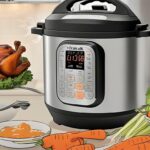Have you ever stood over your stove, watching a shimmering pool of oil defiantly migrate to your pan’s sides, leaving the center virtually bare? This culinary curiosity often leaves home cooks and food enthusiasts scratching their heads, staring quizzically at their rebellious liquid.
It’s a kitchen conundrum that begs the question: why doesn’t oil stay put in the middle of the pan? Brace yourself for a dive into the captivating world of kitchen science, where heat, physics, and a bit of gastronomic geometry converge to solve this slick mystery.
Oil and Heat:
Oil is an essential ingredient for our culinary delights and a fascinating subject in physics. To fully appreciate our oily inquiry, we first need to grasp two fundamental concepts: viscosity and surface tension.
Viscosity is a measure of a fluid’s resistance to flow. Think of it as the “thickness” or “stickiness” of a liquid. Cold oil, for instance, is more viscous than hot oil because the molecules move more slowly and stick together more in the colder state. As we heat oil, it becomes less dense, meaning it flows more easily.
Meanwhile, surface tension, another pivotal property of liquids, is the force that makes a liquid behave like a stretched elastic sheet. When oil is heated, its surface tension decreases. This, combined with the reduced viscosity, allows the oil to spread more readily across the pan. It’s why some small insects can walk on water without sinking.
Now, combine these fluid dynamics with the nature of heat. Heat isn’t something that just statically sits where it’s put – it loves to move and spread, a process known as heat conduction.
When you place your pan on the stove, the heat doesn’t uniformly disperse across the pan; instead, it travels from areas of high heat (the center of the pan, directly above the burner) to areas of lower heat (the sides). This uneven heat distribution plays a critical role in the behavior of oil in the pan.
Why Does Oil not Stay in the Middle of the Pan?
Oil does not stay in the middle of the pan due to a combination of factors:
- Heat distribution: The heat source from the stove heats the pan unevenly, making it hotter in the center than at the edges. The oil in the center heats up and expands, becoming less dense, and then moves towards the cooler, denser oil at the edges in a process known as convection.
- Pan shape: Most pans aren’t perfectly flat. When heated, they have a slightly more pronounced curve, encouraging the oil to move toward the edges.
- Properties of oil: When oil is heated, it becomes less dense (flows more easily) and its surface tension decreases, allowing it to spread out more readily.
The Science Behind the Phenomenon
Now that we’ve established the fundamental principles of oil behavior and heat distribution let’s unravel the mystery of wandering oil.
Heat transfer in a pan isn’t uniform. When you heat a pan on the stove, the section directly above the flame or heating element gets hot first and tends to be the hottest part. However, heat doesn’t like to stay put. It naturally moves from the warmer area to cooler areas in a process called conduction, gradually spreading throughout the pan.
However, the edges of the pan are exposed to the air and lose heat faster than the center. This creates a temperature gradient in the pan: hotter in the center and cooler at the edges. Now, enter our hero, the oil. When you pour oil into the pan, it quickly heats up, especially in the center. As the oil warms, it becomes less dense and its surface tension decreases, spreading it more readily.
Here’s where things get interesting. The oil in the center of the pan, which is hotter, expands. This expansion causes it to become less dense than the oil near the edges. And what happens when there’s a difference in density? The less-dense substance rises, and the denser substance sinks, a process known as convection.
The heated, less dense oil moves toward the cooler edges of the pan, pushing the denser, cooler oil toward the center, where it heats up, and the process repeats. This circulation pattern, driven by density differences due to heat, leads to the oil pooling at the edges of the pan and leaving the center.
The Role of the Pan
The role of the pan in our kitchen problem is twofold: its shape and material. These two factors are crucial in how heat is distributed and how oil behaves in the pan.
Firstly, let’s consider the shape of the pan. Most pans aren’t perfectly flat; they have a slight curvature or “bowl” shape that becomes more pronounced when heated. This warping happens because the metal expands when it gets hot, and the base of the pan expands slightly more in the center than at the edges. This creates a subtle concave shape, naturally encouraging the oil to slide towards the sides.
Now, onto the pan’s material. Pans are made from various materials, such as cast iron, stainless steel, aluminum, copper, and combinations. Each of these materials has a different thermal conductivity, meaning they conduct heat at different rates. For instance, copper and aluminum pans heat up more evenly than cast iron or stainless steel pans, which have ‘hot spots’. These variations in heat distribution across the pan further influence the movement of oil.
Implications for Cooking
Understanding this slippery dance of oil can have a real impact on your culinary prowess. The center of the pan, where the oil tends to thin out, is often the hottest spot. This is great for searing a steak or achieving that golden-brown crust on your grilled cheese. However, if you’re not mindful, it could also lead to uneven cooking or, worse, burning your food.
Here are some tips to help you manage the migrating oil and heat distribution in your pan:
- Preheat your pan: Before adding oil, let your pan heat up evenly. This can minimize warping and promote a more uniform heat distribution.
- Move it around: Don’t just pour your oil and let it sit. Use a spatula or tilt the pan to spread the oil, ensuring it coats the entire surface, including the sides.
- Match your pan and heat source size: If your burner is much smaller than your pan, the center will heat up more, exacerbating the oil’s migration. Try to match the size of your pan to your heat source as closely as possible.
- Choose the right pan: As we’ve seen, the material and shape of your pan can affect how the oil behaves. Depending on what you’re cooking, different pans may be more suitable. For instance, a heavy-bottomed cast-iron pan retains heat well and may provide a more uniform cooking surface.
- Use enough oil: If you’re barely coating the bottom of your pan, the oil is more likely to pool at the edges. Enough oil to cover the pan’s surface can help provide a more even cooking medium.
Why are Some Frying Pans Higher in the Middle?
This is where the latent heat of the frying pans comes to play a vital row. The heat capacity of the frying pan should be proportional to the heat supplied. Steadily and steadfastly supplying heat to the bottom of the pan, especially the core part of the pan bottom raised.
The materials for constructing the frying pan have a vast row to play. Multiple-ply stainless steel frying pans don’t warp easily because of the high-warping resistance.
On the other hand, aluminum are not like that; they are the opposite. Buying frying pans doped with stainless steel and aluminum materials have a high latent heat capacity, and they don’t dome easily.
 Final Words
Final Words
This article goes way beyond closing a frying pan. It covers notable questions that come with cooking. You can use our information to boost your buying choice, cooking terminologies, and approaches to making a nice dessert. Nevertheless, you’re impugned to get the best use of the pieces of information here so that you can make every bit and minute worth the experience.
- What is a Stock Pot Used for in Cooking? - September 5, 2023
- How to Make Turkey Stock in Instant Pot - September 5, 2023
- How to Make Gravy from Pot Roast Stock - September 5, 2023







